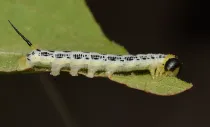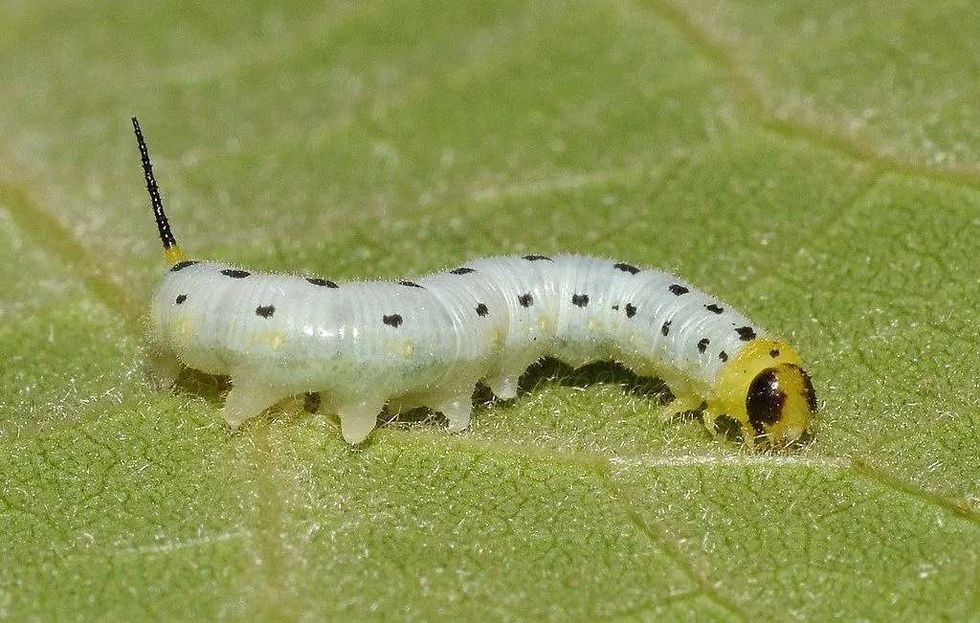Are you interested to know more about moth species? If yes, then you would surely be interested to learn about the catalpa sphinx moth that hails from southeastern North America.
The caterpillar of this species is used as fish bait and it's found on the leaves of the North American species of catalpa plants. It belongs to the Lepidoptera order and the Sphingidae family. Adult moths look plain and have brown wings.
But, the caterpillars are usually a mix of black and yellow. But, caterpillars do go through a pale and dark stage of molting.
It's thought to be a common pest in states like Ohio and Texas, people often find ways to get rid of it from the plants. Adults can mainly be seen during the spring and summer months when it mates and lays eggs on the host plants.
You may often hear about this species whenever there is an outbreak. So, keep reading to know more interesting catalpa sphinx moth facts. Also, check out the articles on rose maple moth and imperial moth.
Catalpa Sphinx Moth Interesting Facts
What type of animal is a catalpa sphinx moth?
The catalpa sphinx moth is a species belonging to the hawk moth family. Ceratomia catalpae is the catalpa sphinx moth scientific name. Another popular moth species is the giant leopard moth.
What class of animal does a catalpa sphinx moth belong to?
The catalpa sphinx moth belongs to the class Insecta and to the order Lepidoptera. Even the five-spotted hawk moth belongs to the same order.
How many catalpa sphinx moths are in the world?
We don't know the exact catalpa sphinx moth range of population as it's ever-changing, and no conclusive studies are found that describes the trend.
Where does a catalpa sphinx moth live?
The catalpa sphinx moth is regarded as native to southeastern North America. It's found in the US states like Maine, Iowa, Florida, Texas, Ohio, and the Gulf states. Outbreaks of the catalpa sphinx moth caterpillar has also been seen as far as Nebraska and Colorado.
What is a catalpa sphinx moth's habitat?
The catalpa sphinx moth lar0vae is exclusively found in areas that have native catalpa trees. It's known to be the sole host plant species of the caterpillars and both northern and southern variants are used by caterpillars.
When there's an outbreak in a region, it can lead to defoliation of the trees and people resort to finding ways to control the worms.
Who do catalpa sphinx moths live with?
As adults, most moths will be solitary and on the lookout for mating. However, as a caterpillar, you can find the hornworms as a group attached to the leaves of the host trees of catalpa for sustenance.
How long does a catalpa sphinx moth live?
We don't know the exact lifespan of the Ceratomia catalpae species, but adult sphinx moths usually live for about 10 to 30 days.
How do they reproduce?
Adult catalpa moths can mainly be seen during the spring and summer seasons when it's busy mating and depositing the eggs on the tree. A female can deposit up to 1,000 eggs at a time between the months of April and May.
It takes 10 - 14 days for the caterpillars to emerge from the eggs and start chomping on the leaves of the catalpa tree. In a year up to four generations of this moth can be seen.
The caterpillar of this species is known as a hornworm because of the presence of a black horn. It's considered to be a pest for the plants. Just before the winter, hornworms turn into pupa.
Then, the pupas fall to the ground and lodge into the soil to overwinter. It gets 2-3 in (5-7.6 cm) into the soil.
What is their conservation status?
The catalpa sphinx moth is yet to be included in any conservation lists.
Catalpa Sphinx Moth Fun Facts
What do catalpa sphinx moths look like?
The catalpa sphinx moth is usually brown in color with white and black spots. These plain looking insects are often overlooked and it gets well camouflaged with a tree.
However, the interest lies in the caterpillar which is also known as a hornworm for its black horn. This is also considered a pest because an outbreak of catalpa sphinx moth catalpa tree can lead to defoliation. Moreover, the caterpillars look quite interesting and the look changes as it starts to grow.
When the larvae first hatch, it's usually white or pale yellow, and after growing up a little, black spots emerge on the white body. The grown-up caterpillar may have different appearances, but the most common worms have a pale yellow underside with black stripes on the back.
In the grown-up caterpillars, broad yellow stripes can be seen on the side.

How cute are they?
Even though the moths can't be said to be as cute as an adorable species like the poodle moth, but the catalpa sphinx moth larvae do stand out because of its coloration.
How do they communicate?
We are yet to know a lot about how moths communicate, but it's assumed that adult females use pheromones to attract males during the mating season.
How big is a catalpa sphinx moth?
The average body size range of the catalpa sphinx moth adult is around 1.1 in (30 mm). And, the wingspan of this species is around 2.5-3.7 in (6.5-9.5 cm). The catalpa sphinx moth caterpillar measures around 2 in (5 cm). In comparison, the gypsy moth adult has a size of around 0.6-1.4 in (1.5-3.5 cm).
How fast can catalpa sphinx moths fly?
We don't know the exact speed range of catalpa sphinx moths, but the sphinx moth usually can travel at a rate of up to 34 mph (55 kph). On the other hand, the catalpa sphinx moth caterpillar isn't very fast, but it can very well eat through catalpa tree leaves which leads to defoliation.
How much does a catalpa sphinx moth weigh?
We don't know the weight range of these moths but we can assume that it's minuscule.
What are the male and female names of the species?
There are no specific names for the male and female of this species.
What would you call a baby catalpa sphinx moth?
A baby catalpa sphinx moth is known as a larva or caterpillar.
What do they eat?
The adult catalpa sphinx moth probably feeds on the nectar from flowers. Sphinx moths are especially known for having long tongues to feed on flowers with long throats.
However, the catalpa worms or caterpillars are known for feasting on the leaves of catalpa trees, which is the host plant for the species and it can even lead to defoliation of a tree.
Are they poisonous?
No, neither the caterpillar nor the adult catalpa sphinx moth is poisonous in nature.
Would they make a good pet?
If you are really interested in seeing the transformation of the catalpa worm sphinx moth then try to search for them in the wild. You can search for the caterpillars and house a couple in a tank.
Make sure to have access to the leaves of catalpa trees as that's the only thing catalpa worms feed on. But most agree that it is better to leave these animals in the wild and to observe nature from afar, rather than trying to catch hold of it.
Did you know...
You can handpick the caterpillar from catalpa trees to use as fish bait.
What month do catalpa worms come out?
The catalpa worms or caterpillars can usually be seen during late June to early July for about two weeks. This is the time when many people catch the caterpillars to make fish bait.
How to get rid of catalpa sphinx caterpillars and moths?
The easiest way to get rid of the catalpa sphinx is to attack the eggs. Usually, caterpillars of this moth can be seen under the leaves of catalpa trees.
You can wash off the eggs from the leaves to control the population. If the eggs have already turned into caterpillars, you can try to cut away the specific leaves where it is dwelling to limit its food. Or, you can release natural predators like wasps and flies that attack the caterpillars.
Some people even like to handpick the caterpillars do drown in soapy water as an easy control. The catalpa sphinx moth pupa lives in the ground, so you can dig up the soil to disrupt the process and bring an end to its life.
Caterpillars are also targeted with products containing B.T. that works as a natural pesticide. And, we will suggest you not to use the usual insecticides found on the market as it can destroy other natural species occurring near the catalpa tree.
Here at Kidadl, we have carefully created lots of interesting family-friendly animal facts for everyone to discover! Learn more about some other arthropods from our puss moth facts and gold moth facts pages.
You can even occupy yourself at home by coloring in one of our free printable luna moth coloring pages.
Both images are by Andy Reago and Chrissy McClarren.










